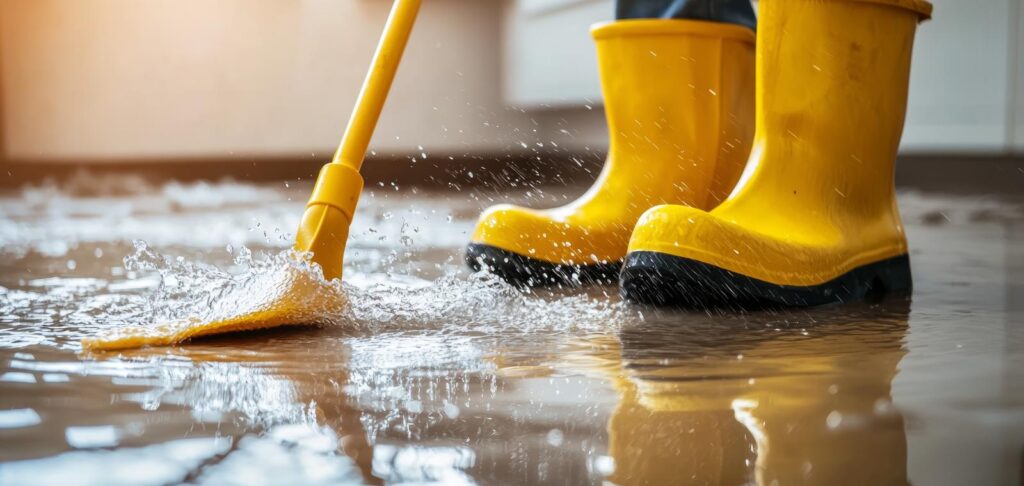
Contents
When you face flood damage, evaluating the damage, extracting water, and drying the area are essential steps. You’ll need to clean and sanitize affected surfaces, repair any structural issues, and implement preventive measures. Each phase is critical for restoring your space and preventing future problems. Understanding this process not only prepares you for potential challenges but also equips you with the knowledge to safeguard your property effectively. What comes next might surprise you.
Key Takeaways
- Conduct a thorough assessment of damage, noting structural issues, moisture levels, and documenting findings with photographs for insurance claims.
- Extract water using submersible pumps and wet/dry vacuums, then set up fans and dehumidifiers for drying.
- Clean and sanitize all affected areas using specialized solutions to eliminate contaminants and pathogens.
- Repair structural damage by replacing compromised materials and consulting professionals for electrical or plumbing issues.
- Implement preventive measures like improving drainage systems and installing flood barriers to protect against future flooding.
Assessing the Damage
Before you can tackle flood damage repair, it’s crucial to assess the extent of the damage thoroughly. Start by walking through each affected area, noting visible signs like soaked carpets, warped flooring, or peeling paint.
Check for structural issues, such as cracks in walls or ceilings, which might indicate deeper problems. Utilize a moisture meter to gauge hidden moisture levels in walls and floors; this’ll help you identify hard-to-reach areas that need attention.
Keep a detailed list of your findings, including photographs for reference. Don’t forget to document any belongings that are damaged beyond repair.
Understanding the full scope of the damage not only helps prioritize repairs but can also be significant for insurance claims. This assessment phase lays the groundwork for effective repair work, ensuring you’re well-equipped to restore your space and foster a sense of belonging once again.
Water Extraction and Drying
Once you’ve assessed the damage, the next critical step is water extraction and drying, as standing water can lead to further deterioration and mold growth.
Start by using a submersible pump to remove large volumes of water quickly. If the water is shallow, a wet/dry vacuum can help you clear out the remaining moisture effectively.
Once the bulk of the water is gone, it’s crucial to focus on drying out the affected areas. Set up industrial fans and dehumidifiers to circulate air and reduce humidity levels. Open windows if possible to promote airflow.
Pay special attention to hidden spaces, like behind walls or under flooring, where moisture might linger.
After you’ve completed this process, the structure should be considerably drier, setting the stage for the next steps in your flood damage repair journey.
Cleaning and Sanitizing
Cleaning and sanitizing the affected areas is essential for restoring your space and preventing health hazards.
After water extraction and drying, it’s time to tackle contaminants like mold, bacteria, and dirt.
You’ll want to follow a systematic approach to guarantee thorough cleaning.
Use specialized cleaning solutions that are effective against flood-related contaminants.
Scrub surfaces meticulously, paying close attention to corners and crevices where grime can hide.
Disinfect all affected areas to eliminate any lingering pathogens.
Repairing Structural Damage
As you assess the aftermath of a flood, repairing structural damage becomes a crucial step in restoring your property’s integrity. Start by carefully inspecting the foundation, walls, and roof for any signs of weakness or deterioration. Look for cracks, warping, or mold, as these issues can compromise safety.
Next, consult with a structural engineer if significant damage is found; their expertise guarantees you address all concerns properly. For minor repairs, you might need to replace damaged drywall, insulation, or flooring. Use materials that are water-resistant to prevent future issues.
Don’t forget to check electrical and plumbing systems; hire professionals to handle any repairs in these areas, as they require specialized knowledge.
Finally, reinforce your property with proper drainage solutions and durable materials to enhance resilience against future floods. By taking these steps, you help secure your home and create a safe space for you and your loved ones.
Preventing Future Flooding
After addressing structural damage, it’s important to focus on preventing future flooding. You can take proactive steps to safeguard your home and family from potential water damage.
Start by evaluating your property’s drainage system to verify it effectively directs water away from your foundation.
Consider these essential measures:
Install gutters and downspouts that are clean and direct water at least three feet away from your home.
Landscape with native plants that absorb excess rainwater, creating a natural barrier against flooding.
Invest in flood barriers or sandbags to protect entry points during heavy storms.
Final Thoughts
In summary, successfully maneuvering through the flood damage repair process requires careful attention to detail at every step. By thoroughly evaluating the damage, extracting water, and ensuring proper cleaning, you lay the groundwork for effective repairs. As you implement preventive measures, you’ll not only restore your space but also protect it from future incidents. Isn’t it worth taking these steps to safeguard your home from the unpredictability of floods? Your proactive approach can make all the difference.
Recent Posts
Comprehensive Guide to Flood Damage Repair Process
Flooding can devastate your property in ways you might not even imagine. To effectively tackle
5 Best Steps for Flood Damage Repair
When faced with flood damage, it’s essential to approach the repair process systematically. Start by
Unlocking the Secrets of Water Extraction Tools
When tackling water extraction, understanding the tools at your disposal is essential. Each type of
